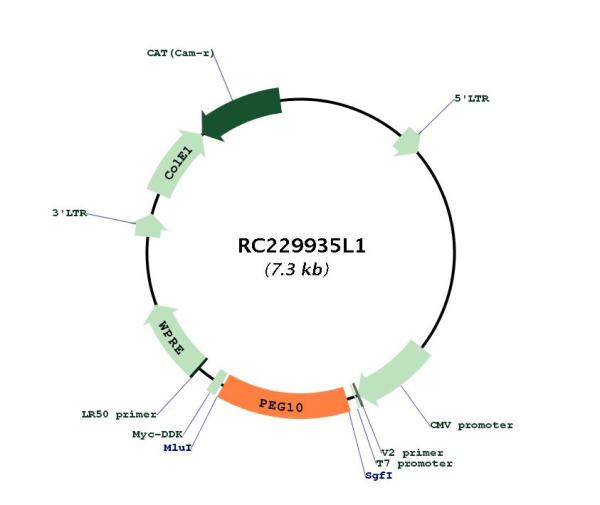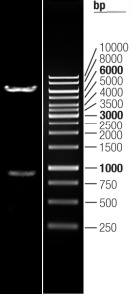PEG10 (NM_001184962) Human Tagged Lenti ORF Clone
CAT#: RC229935L1
- LentiORF®
Lenti ORF clone of Human paternally expressed 10 (PEG10), transcript variant 1, Myc-DDK-tagged
"NM_001184962" in other vectors (6)
Need custom modification / cloning service?
Get a free quote
CNY 6,000.00
| Cited in 1 publication. |
CNY 1,999.00
CNY 2,700.00
CNY 600.00
Specifications
| Product Data | |
| Type | Human Tagged ORF Clone |
| Tag | Myc-DDK |
| Synonyms | EDR; HB-1; Mar2; Mart2; MEF3L; RGAG3; RTL2; SIRH1 |
| Vector | pLenti-C-Myc-DDK |
| E. coli Selection | Chloramphenicol (34 ug/mL) |
| Mammalian Cell Selection | None |
| Sequence Data |
The ORF insert of this clone is exactly the same as(RC229935).
|
| Restriction Sites |
SgfI-MluI
Cloning Scheme for this gene
Plasmid Map

|
| ACCN | NM_001184962 |
| ORF Size | 975 bp |
| OTI Disclaimer | Due to the inherent nature of this plasmid, standard methods to replicate additional amounts of DNA in E. coli are highly likely to result in mutations and/or rearrangements. Therefore, OriGene does not guarantee the capability to replicate this plasmid DNA. Additional amounts of DNA can be purchased from OriGene with batch-specific, full-sequence verification at a reduced cost. Please contact our customer care team at custsupport@origene.com or by calling 301.340.3188 option 3 for pricing and delivery. The molecular sequence of this clone aligns with the gene accession number as a point of reference only. However, individual transcript sequences of the same gene can differ through naturally occurring variations (e.g. polymorphisms), each with its own valid existence. This clone is substantially in agreement with the reference, but a complete review of all prevailing variants is recommended prior to use. More info |
| OTI Annotation | This clone was engineered to express the complete ORF with an expression tag. Expression varies depending on the nature of the gene. |
| Product Components | The ORF clone is ion-exchange column purified and shipped in a 2D barcoded Matrix tube containing 10ug of transfection-ready, dried plasmid DNA (reconstitute with 100 ul of water). |
| Reconstitution | 1. Centrifuge at 5,000xg for 5min. 2. Carefully open the tube and add 100ul of sterile water to dissolve the DNA. 3. Close the tube and incubate for 10 minutes at room temperature. 4. Briefly vortex the tube and then do a quick spin (less than 5000xg) to concentrate the liquid at the bottom. 5. Store the suspended plasmid at -20°C. The DNA is stable for at least one year from date of shipping when stored at -20°C. |
| Reference Data | |
| RefSeq | NM_001184962.1 |
| RefSeq Size | 6628 bp |
| RefSeq ORF | 1080 bp |
| Locus ID | 23089 |
| UniProt ID | Q86TG7 |
| MW | 37 kDa |
| Gene Summary | This is a paternally expressed imprinted gene that is thought to have been derived from the Ty3/Gypsy family of retrotransposons. It contains two overlapping open reading frames, RF1 and RF2, and expresses two proteins: a shorter, gag-like protein (with a CCHC-type zinc finger domain) from RF1; and a longer, gag/pol-like fusion protein (with an additional aspartic protease motif) from RF1/RF2 by -1 translational frameshifting (-1 FS). While -1 FS has been observed in RNA viruses and transposons in both prokaryotes and eukaryotes, this gene represents the first example of -1 FS in a eukaryotic cellular gene. This gene is highly conserved across mammalian species and retains the heptanucleotide (GGGAAAC) and pseudoknot elements required for -1 FS. It is expressed in adult and embryonic tissues (most notably in placenta) and reported to have a role in cell proliferation, differentiation and apoptosis. Overexpression of this gene has been associated with several malignancies, such as hepatocellular carcinoma and B-cell lymphocytic leukemia. Knockout mice lacking this gene showed early embryonic lethality with placental defects, indicating the importance of this gene in embryonic development. Additional isoforms resulting from alternatively spliced transcript variants, and use of upstream non-AUG (CUG) start codon have been reported for this gene. [provided by RefSeq, Oct 2014] |
Citations (1)
| The use of this cDNA Clones has been cited in the following citations: |
|---|
|
PEG10 counteracts signaling pathways of TGF-β and BMP to regulate growth, motility and invasion of SW1353 chondrosarcoma cells
,Yahiro, Y;Maeda, S;Shinohara, N;Jokoji, G;Sakuma, D;Setoguchi, T;Ishidou, Y;Nagano, S;Komiya, S;Taniguchi, N;,
J. Bone Miner. Metab.
,PubMed ID 30094509
[PEG10]
|
Documents
| Product Manuals |
| FAQs |
| SDS |
Resources
Other Versions
| SKU | Description | Size | Price |
|---|---|---|---|
| RC229935 | PEG10 (Myc-DDK-tagged)-Human paternally expressed 10 (PEG10), transcript variant 1 |
CNY 3,600.00 |
|
| RC229935L2 | Lenti ORF clone of Human paternally expressed 10 (PEG10), transcript variant 1, mGFP tagged |
CNY 5,890.00 |
|
| RC229935L3 | Lenti ORF clone of Human paternally expressed 10 (PEG10), transcript variant 1, Myc-DDK-tagged |
CNY 5,890.00 |
|
| RC229935L4 | Lenti ORF clone of Human paternally expressed 10 (PEG10), transcript variant 1, mGFP tagged |
CNY 6,000.00 |
|
| RG229935 | PEG10 (tGFP-tagged) - Human paternally expressed 10 (PEG10), transcript variant 1 |
CNY 4,370.00 |
|
| SC328573 | PEG10 (untagged)-Human paternally expressed 10 (PEG10) transcript variant 1 |
CNY 7,220.00 |


 United States
United States
 Germany
Germany
 Japan
Japan
 United Kingdom
United Kingdom
 China
China


